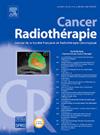放射治疗中计算机断层图像自动肝脏分割的定性评价
IF 1.4
4区 医学
Q4 ONCOLOGY
引用次数: 0
摘要
目的计算机断层扫描(CT)图像中靶体积和危险器官的分割是放疗工作流程中的重要步骤。基于人工智能的方法显著改善了医学图像中的器官分割。自动分割通常使用几何度量来评估。在放疗工作流程的临床实施之前,自动分割也必须由临床医生进行评估。本研究的目的是调查用于分割评估的几何指标与临床医生进行的评估之间的相关性。材料和方法在本研究中,我们使用U-Net模型从公开可用的数据集中分割CT图像中的肝脏。模型的性能用两个几何指标来评估:Dice相似系数和Hausdorff距离。此外,临床医生对自动分割进行了定性评估,以评估其在放疗工作流程中使用的临床可接受性。研究几何指标与临床医师评价的相关性。结果Dice系数和Hausdorff距离是分割精度的可靠指标,但并不总是与临床医生的分割一致。在某些情况下,高Dice分数的分割仍然需要临床医生在临床使用放射治疗工作流程之前进行校正。结论本研究强调了在几何测量之外需要更全面的评估指标来评估基于人工智能的分割的临床可接受性。尽管深度学习模型提供了有希望的分割结果,但目前的研究表明,标准化的验证方法对于确保自动分割系统的临床可行性至关重要。本文章由计算机程序翻译,如有差异,请以英文原文为准。
Qualitative evaluation of automatic liver segmentation in computed tomography images for clinical use in radiation therapy
Purpose
Segmentation of target volumes and organs at risk on computed tomography (CT) images constitutes an important step in the radiotherapy workflow. Artificial intelligence-based methods have significantly improved organ segmentation in medical images. Automatic segmentations are frequently evaluated using geometric metrics. Before a clinical implementation in the radiotherapy workflow, automatic segmentations must also be evaluated by clinicians. The aim of this study was to investigate the correlation between geometric metrics used for segmentation evaluation and the assessment performed by clinicians.
Materials and Methods
In this study, we used the U-Net model to segment the liver in CT images from a publicly available dataset. The model's performance was evaluated using two geometric metrics: the Dice similarity coefficient and the Hausdorff distance. Additionally, a qualitative evaluation was performed by clinicians who reviewed the automatic segmentations to rate their clinical acceptability for use in the radiotherapy workflow. The correlation between the geometric metrics and the clinicians’ evaluations was studied.
Results
The results showed that while the Dice coefficient and Hausdorff distance are reliable indicators of segmentation accuracy, they do not always align with clinician segmentation. In some cases, segmentations with high Dice scores still required clinician corrections before clinical use in the radiotherapy workflow.
Conclusion
This study highlights the need for more comprehensive evaluation metrics beyond geometric measures to assess the clinical acceptability of artificial intelligence-based segmentation. Although the deep learning model provided promising segmentation results, the present study shows that standardized validation methodologies are crucial for ensuring the clinical viability of automatic segmentation systems.
求助全文
通过发布文献求助,成功后即可免费获取论文全文。
去求助
来源期刊

Cancer Radiotherapie
医学-核医学
CiteScore
2.20
自引率
23.10%
发文量
129
审稿时长
63 days
期刊介绍:
Cancer/radiothérapie se veut d''abord et avant tout un organe francophone de publication des travaux de recherche en radiothérapie. La revue a pour objectif de diffuser les informations majeures sur les travaux de recherche en cancérologie et tout ce qui touche de près ou de loin au traitement du cancer par les radiations : technologie, radiophysique, radiobiologie et radiothérapie clinique.
 求助内容:
求助内容: 应助结果提醒方式:
应助结果提醒方式:


